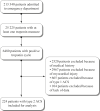Diagnosis and Management of Type 2 Acute Coronary Syndrome in Patients Without Pre-existing Cardiomyopathy in Centers With and Without Percutaneous Coronary Intervention
- PMID: 40438809
- PMCID: PMC12118945
- DOI: 10.7759/cureus.83137
Diagnosis and Management of Type 2 Acute Coronary Syndrome in Patients Without Pre-existing Cardiomyopathy in Centers With and Without Percutaneous Coronary Intervention
Abstract
Introduction Type 2 acute coronary syndrome (ACS) is defined as myocardial infarction caused by an imbalance between myocardial oxygen supply and demand. Although several observational studies have been conducted, they have not led to the development of clear clinical guidelines, partly due to heterogeneous definitions and the absence of consensus regarding diagnostic criteria and management strategies. Aims To assess diagnostic practices and management of type 2 ACS in patients without pre-existing heart disease and to analyze these practices based on the availability of coronary angiography at the inclusion center. Methods We retrospectively reviewed the records of 25,225 patients who received a troponin assay in the emergency departments of two centers, one with and the other without coronary angiography facilities, from 2018 to 2019. We selected 224 patients without pre-existing heart disease who had type 2 ACS according to objective criteria. The study was designed as a retrospective, descriptive, and comparative analysis. Data on clinical characteristics, diagnostic labeling, and management strategies, including cardiology consultations and ischemic investigations, were collected and analyzed. Results The study populations from both centers were similar. Clinicians diagnosed type 2 ACS in only three (1.3%) cases, despite a high rate of cardiology consultations (180, 80.4%). Exploration was performed in 78 (34.8%) patients, revealing significant coronary lesions in 43 (64.2%) cases. In 118 (74.7%) patients without exploration during hospitalization, no rationale was documented. The presence of on-site coronary angiography did not significantly influence the decision to explore (p = 0.067). Exploration decisions were influenced by age (p < 0.001), family history (p = 0.006), ECG presentation (p = 0.034), left ventricular ejection fraction (LVEF) (p = 0.02), and cardiology consultation request (p < 0.001). Conclusion Objective criteria allowed the selection of a homogeneous type 2 ACS population. The diagnosis is rarely made, highlighting the need for increased awareness among emergency physicians and cardiologists. Integrating objective criteria into clinical guidelines could be considered. Given the high rate of underlying coronary lesions, patients with type 2 ACS and no pre-existing heart disease should be prioritized for coronary exploration.
Keywords: acute coronary syndrome; coronary angiography; emergency reception service; oxygen consumption; troponin; type 2 myocardial infarction.
Copyright © 2025, Fournier et al.
Conflict of interest statement
Human subjects: Consent for treatment and open access publication was obtained or waived by all participants in this study. Animal subjects: All authors have confirmed that this study did not involve animal subjects or tissue. Conflicts of interest: In compliance with the ICMJE uniform disclosure form, all authors declare the following: Payment/services info: All authors have declared that no financial support was received from any organization for the submitted work. Financial relationships: All authors have declared that they have no financial relationships at present or within the previous three years with any organizations that might have an interest in the submitted work. Other relationships: All authors have declared that there are no other relationships or activities that could appear to have influenced the submitted work.
Figures




References
-
- Fourth universal definition of myocardial infarction (2018) Thygesen K, Alpert JS, Jaffe AS, Chaitman BR, Bax JJ, Morrow DA, White HD. J Am Coll Cardiol. 2018;72:2231–2264. - PubMed
-
- The many faces of type 2 myocardial infarction. Januzzi JL, Sandoval Y. J Am Coll Cardiol. 2017;70:1569–1572. - PubMed
-
- Mortality rate in type 2 myocardial infarction: observations from an unselected hospital cohort. Saaby L, Poulsen TS, Diederichsen AC, et al. Am J Med. 2014;127:295–302. - PubMed
-
- Type 2 myocardial infarction and value-based programs: cutting the supply in the absence of demand. McCarthy CP. Am J Med. 2019;132:1117–1118. - PubMed
-
- Type 2 myocardial infarction-Diagnosis, prognosis, and treatment. McCarthy CP, Vaduganathan M, Januzzi JL Jr. JAMA. 2018;320:433–434. - PubMed
LinkOut - more resources
Full Text Sources
